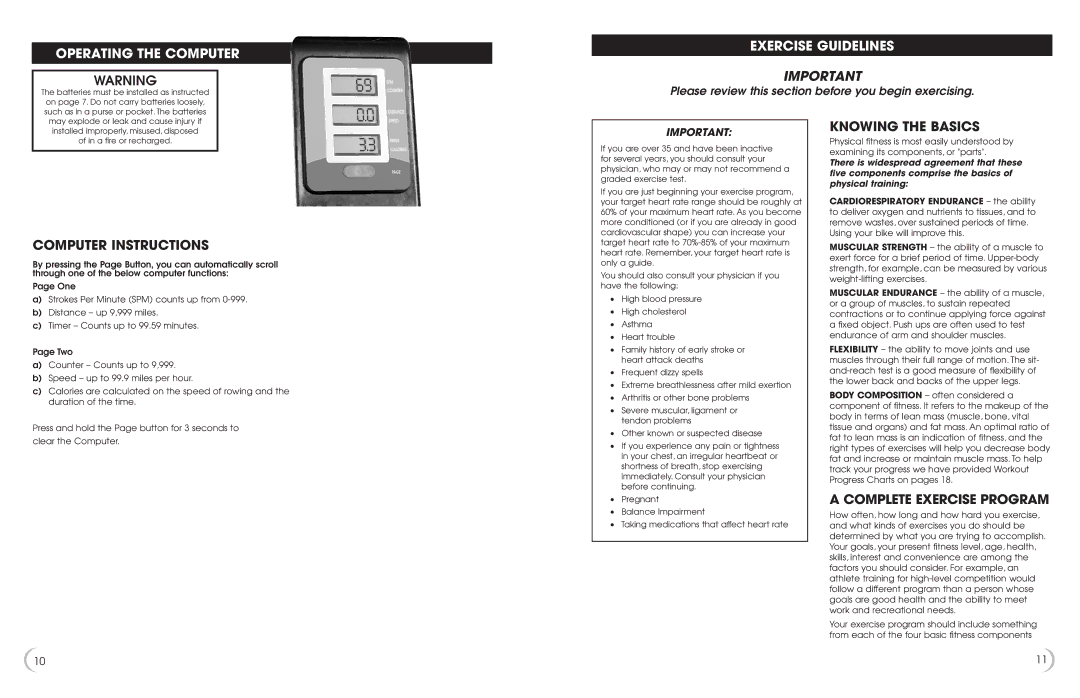
OPERATING THE COMPUTER
WARNING
The batteries must be installed as instructed on page 7. Do not carry batteries loosely, such as in a purse or pocket. The batteries may explode or leak and cause injury if
EXERCISE GUIDELINES
IMPORTANT
Please review this section before you begin exercising.
installed improperly, misused, disposed
of in a fire or recharged.
COMPUTER INSTRUCTIONS
By pressing the Page Button, you can automatically scroll through one of the below computer functions:
Page One
a)Strokes Per Minute (SPM) counts up from
b)Distance – up 9,999 miles.
c)Timer – Counts up to 99.59 minutes.
Page Two
a)Counter – Counts up to 9,999.
b)Speed – up to 99.9 miles per hour.
c)Calories are calculated on the speed of rowing and the duration of the time.
Press and hold the Page button for 3 seconds to
clear the Computer.
IMPORTANT:
If you are over 35 and have been inactive for several years, you should consult your physician, who may or may not recommend a graded exercise test.
If you are just beginning your exercise program, your target heart rate range should be roughly at 60% of your maximum heart rate. As you become more conditioned (or if you are already in good cardiovascular shape) you can increase your target heart rate to
You should also consult your physician if you have the following:
•High blood pressure
•High cholesterol
•Asthma
•Heart trouble
•Family history of early stroke or heart attack deaths
•Frequent dizzy spells
•Extreme breathlessness after mild exertion
•Arthritis or other bone problems
•Severe muscular, ligament or tendon problems
•Other known or suspected disease
•If you experience any pain or tightness in your chest, an irregular heartbeat or shortness of breath, stop exercising immediately. Consult your physician before continuing.
•Pregnant
•Balance Impairment
•Taking medications that affect heart rate
KNOWING THE BASICS
Physical fitness is most easily understood by examining its components, or "parts".
There is widespread agreement that these five components comprise the basics of physical training:
CARDIORESPIRATORY ENDURANCE – the ability to deliver oxygen and nutrients to tissues, and to remove wastes, over sustained periods of time.
Using your bike will improve this.
MUSCULAR STRENGTH – the ability of a muscle to exert force for a brief period of time.
MUSCULAR ENDURANCE – the ability of a muscle, or a group of muscles, to sustain repeated contractions or to continue applying force against a fixed object. Push ups are often used to test endurance of arm and shoulder muscles.
FLEXIBILITY – the ability to move joints and use muscles through their full range of motion. The sit-
BODY COMPOSITION – often considered a component of fitness. It refers to the makeup of the body in terms of lean mass (muscle, bone, vital tissue and organs) and fat mass. An optimal ratio of fat to lean mass is an indication of fitness, and the right types of exercises will help you decrease body fat and increase or maintain muscle mass. To help track your progress we have provided Workout Progress Charts on pages 18.
A COMPLETE EXERCISE PROGRAM
How often, how long and how hard you exercise, and what kinds of exercises you do should be determined by what you are trying to accomplish. Your goals, your present fitness level, age, health, skills, interest and convenience are among the factors you should consider. For example, an athlete training for
Your exercise program should include something from each of the four basic fitness components
10 | 11 |
